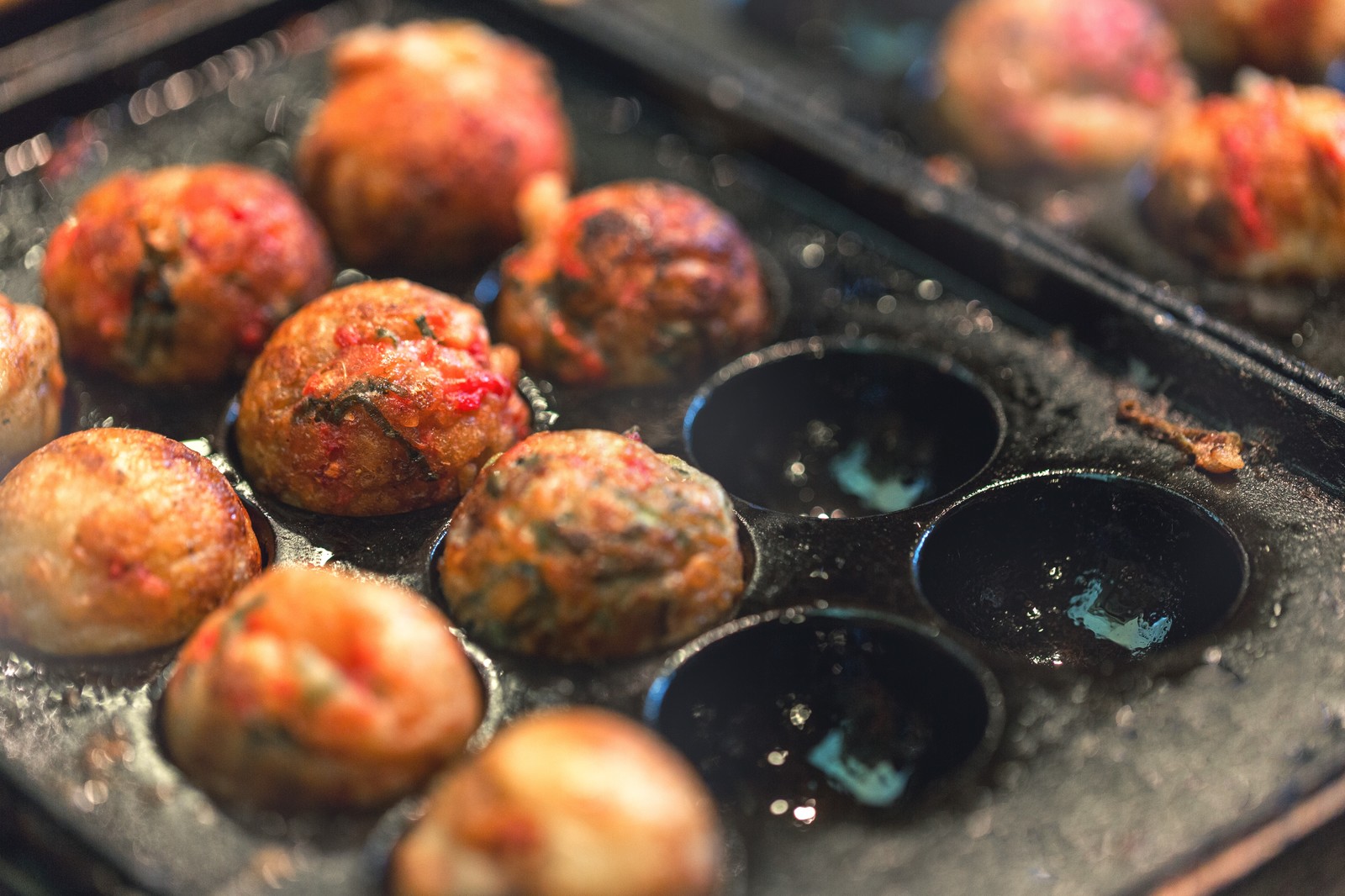
Surely squid is just as good a filling?
Our Japanese language reporter K. Masami recently received a huge amount of squid from some friends who love fishing. While talking with her friends in a group chat about what they’re going to do with the squid, someone suggested, “Let’s have takoyaki!”
Now, takoyaki, as you may know, is a dish of grilled balls of batter stuffed with pieces of octopus (called “tako” in Japanese), but Masami naturally assumed that this friend meant they should make takoyaki with squid (called “ika” in Japanese) instead, an idea that was soundly rejected by the group. But later Masami got to thinking…Why does takoyaki have to have octopus in it? Why not squid?
If we traced back to the origins of takoyaki, we’d find radio-yaki, a dish made by Osaka restaurant Aizuya. Radio-yaki is the same kind of flour-based dumpling as takoyaki, but filled with sinewy beef instead of octopus. At some point, the owner of Aizuya was influenced by Akashi-yaki, a dumpling from Akashi in Hyogo prefecture that’s made with eggs and octopus. That’s when he began making “takoyaki.”
The name “takoyaki” ensured that this particular dish would always be filled with octopus, but it seems like it’d be delicious no matter what you put in there, doesn’t it? Delicious things are sure to attract attention, so just substitute something else for the octopus in takoyaki, and just like that, you have a new hit food, right?
So why don’t we already have all different kinds of non-octopus takoyaki variants? Perhaps other ingredients just can’t live up to the expectations people have of octopus? Whatever the reason, Masami wanted to figure it out, so she decided to try cooking takoyaki with squid, since she had so much on hand.
Masami has actually experimented with takoyaki ingredients before. When she was in high school, she had once manned a takoyaki stall with her class during their school’s culture festival. However, they weren’t allowed to handle raw food, so they decided to use chikuwa, a type of fishcake, instead. She remembers it didn’t have the same firmness of the octopus, but it did have the right amount of savoriness. It wasn’t bad at all, and Masami thought squid should be at least as good as chikuwa.
Masami kept the batter exactly the same as it always is, by following the instructions on the package of takoyaki flour she bought at the supermarket. After pouring the batter into the divots on her takoyaki maker, she started adding the fillings, using squid for half of them and octopus for the other half, so she could compare her idea to the traditional style.
Once the batter was nicely browned in the specialty griddle and the takoyaki were cooked and aromatic, Masami decided she would try them plain first, in order to get the best sense of the differences between them. She started with the familiar taste of octopus takoyaki. The firm texture and mild flavor of the octopus was as reassuring as ever.
Masami has tried Aizuya’s radio-yaki before, but compared to octopus takoyaki, she found the beef to be richer and the dish as a whole to be less snackable. In thinking about it now, it could be that octopus might just be the perfect ingredient to add to balls of soft, hot batter. But…squid could be something special too.
The squid Masami used in her takoyaki experiment was golden cuttlefish, which has a slightly puffy texture. It’s a light kind of squid that, compared to octopus, has a more delicate flavor and less aftertaste. But after trying the squid takoyaki, then going back and trying the octopus takoyaki, and then going back and forth a few times, Masami thought she might understand why octopus is the preferred ingredient.
As you may have noticed by our description of the golden cuttlefish, different kinds of squid have many different textures. Octopus, on the other hand, generally has a single, particular firmness, which provides an interesting contrast with the soft batter. In other words, the octopus is what makes the whole texture of the takoyaki ball work so well.
What’s more, while the mild flavor of squid was overwhelmed by the strong flavor of takoyaki sauce, the flavor of the octopus is actually highlighted by the sauce. Perhaps that’s another reason why octopus just works in takoyaki.
Lastly, if you happen to break open the takoyaki, the purple octopus inside has more visual impact than the white squid.
All in all, octopus just seems to be the perfect filling for takoyaki batter, while squid was just “fine.” Besides, what would you even call takoyaki with squid in it? “Ikayaki” is already taken up by squid grilled on a skewer, a popular festival food, so it’d be a lot harder to come up with a suitable and identifiable name.
So perhaps squid isn’t going to replace octopus in one of Osaka’s most popular street dishes any time soon. Could anything unseat the reign of the octopus? Shrimp seems like it could be a good contender–but then again, so did squid. Perhaps more experimentation is necessary to decide.
Top image: Pakutaso
Insert images © SoraNews24
● Want to hear about SoraNews24’s latest articles as soon as they’re published? Follow us on Facebook and Twitter!

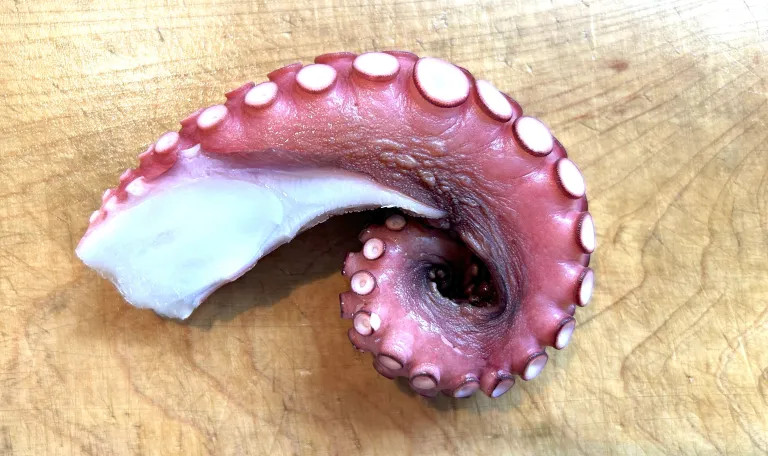
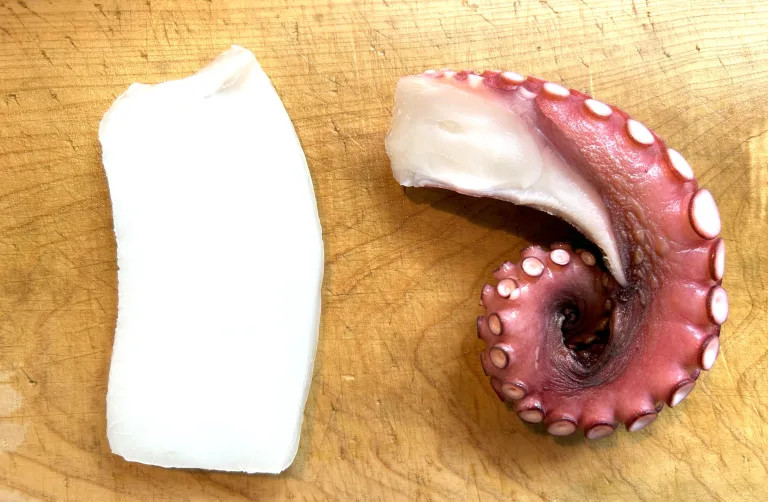
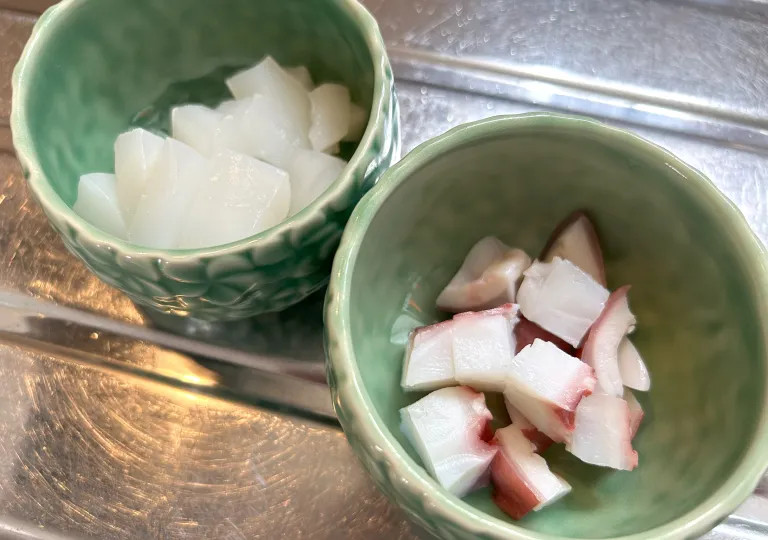

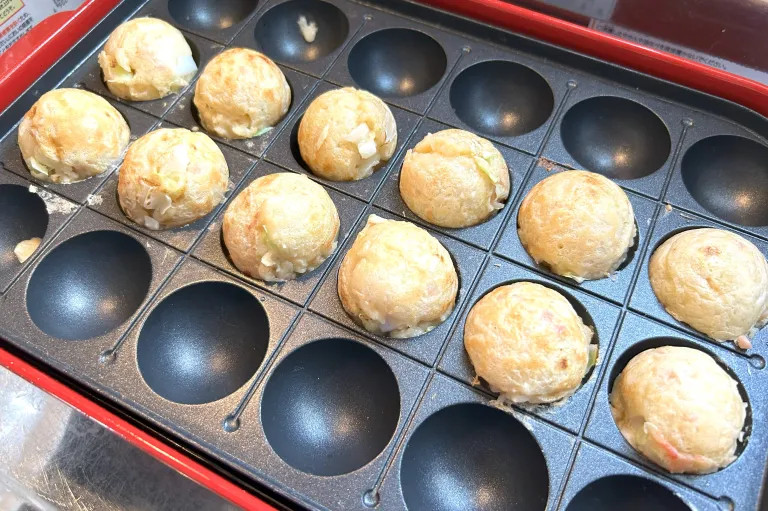

 Takoyaki makers surprisingly good at grilling meat for yakiniku too
Takoyaki makers surprisingly good at grilling meat for yakiniku too Everything you need to know about takoyaki (octopus balls) 【Video】
Everything you need to know about takoyaki (octopus balls) 【Video】 New takoyaki gacha toys designed by a Japanese voice actress come with surprise fillings
New takoyaki gacha toys designed by a Japanese voice actress come with surprise fillings Takoyaki…inarizushi? New fusion food boggles the mind in Japan
Takoyaki…inarizushi? New fusion food boggles the mind in Japan We pig out at Aizuya, the Michelin Guide-featured takoyaki shop
We pig out at Aizuya, the Michelin Guide-featured takoyaki shop Foreigner’s request for help in Tokyo makes us sad for the state of society
Foreigner’s request for help in Tokyo makes us sad for the state of society Japanese city loses residents’ personal data, which was on paper being transported on a windy day
Japanese city loses residents’ personal data, which was on paper being transported on a windy day Japan’s summertime towelket pillowcases are even better with the addition of Ghibli stars【Photos】
Japan’s summertime towelket pillowcases are even better with the addition of Ghibli stars【Photos】 Seaside scenery, history, and so many desserts on Yokohama’s Akai Kutsu【Japan Loop Buses】
Seaside scenery, history, and so many desserts on Yokohama’s Akai Kutsu【Japan Loop Buses】 Should you add tartar sauce to Japanese curry rice? CoCo Ichi makes diners an unusual offer
Should you add tartar sauce to Japanese curry rice? CoCo Ichi makes diners an unusual offer Akihabara pop-up shop sells goods made by Japanese prison inmates
Akihabara pop-up shop sells goods made by Japanese prison inmates Ghibli Park now selling “Grilled Frogs” from food cart in Valley of Witches
Ghibli Park now selling “Grilled Frogs” from food cart in Valley of Witches Red light district sushi restaurant in Tokyo shows us just how wrong we were about it
Red light district sushi restaurant in Tokyo shows us just how wrong we were about it Japan’s cooling body wipe sheets want to help you beat the heat, but which work and which don’t?
Japan’s cooling body wipe sheets want to help you beat the heat, but which work and which don’t? McDonald’s new Happy Meals offer up cute and practical Sanrio lifestyle goods
McDonald’s new Happy Meals offer up cute and practical Sanrio lifestyle goods Japanese ramen restaurants under pressure from new yen banknotes
Japanese ramen restaurants under pressure from new yen banknotes French Fries Bread in Tokyo’s Shibuya becomes a hit on social media
French Fries Bread in Tokyo’s Shibuya becomes a hit on social media Studio Ghibli releases new action figures featuring Nausicaä of the Valley of the Wind characters
Studio Ghibli releases new action figures featuring Nausicaä of the Valley of the Wind characters New private rooms on Tokaido Shinkansen change the way we travel from Tokyo to Kyoto
New private rooms on Tokaido Shinkansen change the way we travel from Tokyo to Kyoto Tokyo Tsukiji fish market site to be redeveloped with 50,000-seat stadium, hotel, shopping center
Tokyo Tsukiji fish market site to be redeveloped with 50,000-seat stadium, hotel, shopping center Beautiful Ghibli sealing wax kits let you create accessories and elegant letter decorations【Pics】
Beautiful Ghibli sealing wax kits let you create accessories and elegant letter decorations【Pics】 Studio Ghibli releases Kiki’s Delivery Service chocolate cake pouches in Japan
Studio Ghibli releases Kiki’s Delivery Service chocolate cake pouches in Japan New definition of “Japanese whiskey” goes into effect to prevent fakes from fooling overseas buyers
New definition of “Japanese whiskey” goes into effect to prevent fakes from fooling overseas buyers Our Japanese reporter visits Costco in the U.S., finds super American and very Japanese things
Our Japanese reporter visits Costco in the U.S., finds super American and very Japanese things All-you-can-drink Starbucks and amazing views part of Tokyo’s new 170 meter-high sky lounge
All-you-can-drink Starbucks and amazing views part of Tokyo’s new 170 meter-high sky lounge More foreign tourists than ever before in history visited Japan last month
More foreign tourists than ever before in history visited Japan last month New Pokémon cakes let you eat your way through Pikachu and all the Eevee evolutions
New Pokémon cakes let you eat your way through Pikachu and all the Eevee evolutions Disney princesses get official manga makeovers for Manga Princess Cafe opening in Tokyo
Disney princesses get official manga makeovers for Manga Princess Cafe opening in Tokyo Sales of Japan’s most convenient train ticket/shopping payment cards suspended indefinitely
Sales of Japan’s most convenient train ticket/shopping payment cards suspended indefinitely Sold-out Studio Ghibli desktop humidifiers are back so Totoro can help you through the dry season
Sold-out Studio Ghibli desktop humidifiers are back so Totoro can help you through the dry season Japanese government to make first change to romanization spelling rules since the 1950s
Japanese government to make first change to romanization spelling rules since the 1950s Ghibli founders Toshio Suzuki and Hayao Miyazaki contribute to Japanese whisky Totoro label design
Ghibli founders Toshio Suzuki and Hayao Miyazaki contribute to Japanese whisky Totoro label design Doraemon found buried at sea as scene from 1993 anime becomes real life【Photos】
Doraemon found buried at sea as scene from 1993 anime becomes real life【Photos】 Tokyo’s most famous Starbucks is closed
Tokyo’s most famous Starbucks is closed One Piece characters’ nationalities revealed, but fans have mixed opinions
One Piece characters’ nationalities revealed, but fans have mixed opinions We asked a Uniqlo employee what four things we should buy and their suggestions didn’t disappoint
We asked a Uniqlo employee what four things we should buy and their suggestions didn’t disappoint Princesses, fruits, and blacksmiths: Study reveals the 30 most unusual family names in Japan
Princesses, fruits, and blacksmiths: Study reveals the 30 most unusual family names in Japan Terrifying Cthulhu-yaki created by lazy Japanese home chef
Terrifying Cthulhu-yaki created by lazy Japanese home chef Survey finds that Osaka people don’t eat takoyaki octopus balls as much as you’d think
Survey finds that Osaka people don’t eat takoyaki octopus balls as much as you’d think Eel-topped takoyaki is delicious in any season, but here’s why now is the best time to try it
Eel-topped takoyaki is delicious in any season, but here’s why now is the best time to try it We miss out on cheap all-you-can-eat takoyaki, but stuff ourselves with octopus balls anyway
We miss out on cheap all-you-can-eat takoyaki, but stuff ourselves with octopus balls anyway Want to be popular with the ladies/men? Be good at making takoyaki, study says
Want to be popular with the ladies/men? Be good at making takoyaki, study says How to turn Cup Noodle instant ramen into delicious Osaka-style dumplings【SoraKitchen】
How to turn Cup Noodle instant ramen into delicious Osaka-style dumplings【SoraKitchen】 Takoyaki stand in Nagoya sold side orders of cocaine, police say
Takoyaki stand in Nagoya sold side orders of cocaine, police say World’s first Takoyaki Guitar created in Japan, features a gas grill and octopus balls
World’s first Takoyaki Guitar created in Japan, features a gas grill and octopus balls Splatoon’s squid vs octopus Splatfest asks deep questions, ruins marriages
Splatoon’s squid vs octopus Splatfest asks deep questions, ruins marriages Great balls of octopus and rice! It’s the Takoyaki Onigiri
Great balls of octopus and rice! It’s the Takoyaki Onigiri New Japanese takoyaki candy tastes so bad, even the makers doubted it would sell
New Japanese takoyaki candy tastes so bad, even the makers doubted it would sell Octopus balls become octopus planets with amazing tweak to takoyaki recipe
Octopus balls become octopus planets with amazing tweak to takoyaki recipe Takoyaki sushi rolls at popular Japanese chain take California rolls to a whole new level
Takoyaki sushi rolls at popular Japanese chain take California rolls to a whole new level New cookbook turns the uni-tasker takoyaki maker into a versatile multi-tasker
New cookbook turns the uni-tasker takoyaki maker into a versatile multi-tasker Takoyaki boat tray comes to life in Japan, sails down river near Tokyo
Takoyaki boat tray comes to life in Japan, sails down river near Tokyo
Leave a Reply